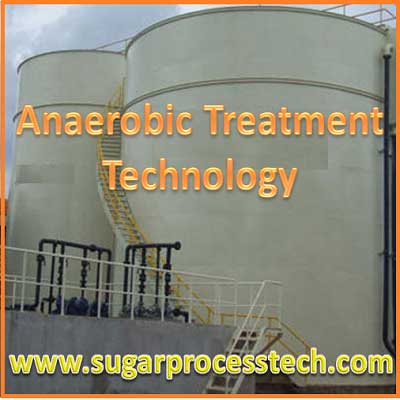In this session discuss about fundamental concepts of anaerobic treatment system with chemical reactions for industrial waste water management and also discussed about nutrient requirement for this process.
Anaerobic Treatment Technology for Sugar Industry Waste water treatment
Anaerobic treatment process is best suited technology for sugar industry waste water treatment. It is one of the biological treatment process for treatment of industrial waste water.
Meaning of Anaerobic Treatment
Anaerobic treatment is a biological process where microorganisms convert organic compounds to methane (CH4), carbon- di- oxide(CO2), cellular materials and other organic compounds in the absence of air.
i.e Anaerobic decomposition of the organic matter in the absence of oxygen.
In this process the sludge is converted biologically into variety of end produces including Methane & O2. The retention period is about two to three days.
Biological Reactions
Anaerobic degradation (or) decomposition is a three stage reaction
a) Hydrolysis of suspended organic solids into soluble organic compound
b) Acetogenesis (or) conversion of soluble organic to volatile fatty acid ( mostly acetic acid)
c) Methanogenesis, or conversion of volatile fatty acid into methane.
Organic waste Organic acids
Organic acids Acetic acid, H2, O2, at 35°C, pH 5-6
Acetic acid Methane(CH4) , CO2 at 45° C, pH 6-8
CH3COO– + H2O → CH4 + HCO3–
CO2 + 4H2 → CH4 + 2H2O
4H2 + CO2 → CH4 + 2H2O
4CH3OH → 3CH4 + CO2 + 2H2O
Energy flow diagram of Anaerobic Digestion Process
Hydrolysis does not occur in all anaerobic treatment process.
Acetogenesis is accomplished step by general class of micro organisms known as the volatile acid formers. The products obtained are the acid salts ( or short – chain fatty acids) viz, acetate propionate and butyrates. Others products are carbon dioxide and new bacteria cells.
Methanogenesis is the formation of methane and carbon dioxide from the decomposition of acetic acid and methane can be produced by decomposition of other volatile acids also.
The methane forming bacteria are more sensitive to environmental conditions such as pH, Temperature and Toxicity etc. the growth rate of mathanogenic bacteria is lower than the acid forming bacteria. There fore it taken more time for methane bacteria to recover from inhibition or shock conditions than it does for the acid forming bacteria.
The methane gas production will be dependent on pH and alkalinity. The optimum pH range for methanogenisis is between 7 & 8 but the methane bacteria generally are not harmful unless the pH drops about 7. It is advisable to maintain pH above 6.5 for anaerobic reactors.
Nutrient Requirement for Anaerobic treatment
For efficient biological treatment, nutrients must be supplied by the wastewater in the normal proportions needed for active microbiological growth.
This is typically about for anaerobic treatment is BOD : N : P rates of 100 : 2.5 : 0.5.
For example : Effluent Flow rate – 800 m3/day with BOD – 1200 mg/liter at the inlet of aeration treatment process and outlet BOD required 240 mg/liter.
Flow rate – 800 m3/day
Inlet BOD – 1200 mg/liter
Outlet BOD – 240 mg/liter
BOD removal = ( Inlet BOD – Outlet BOD ) in mg/ liter = 1200 – 240 = 960 mg/lt = 0.960 kg / m3
Total BOD load on anaerobic system = Effluent flow rate in m3/ day x BOD load in kg/ m3
= 800 x 0.96 = 768 kgs
BOD : Nitrogen : phosphates = 100 : 2.5 : 0.5
i.e 100kg BOD : 2.5kg Nitrogen : 0.5kg phosphorous
For 768 kg BOD,
Nitrogen required = 768 x 2.5 / 100 = 19.2 kg /day
Phosphate required = 768 x 0.5 /100 = 3.8 kg/day
Requirements of nutrients are somewhat lower for lightly loaded systems. For wastewater containing significant carbonaceous industrial waste components, check the need for supplemental feed of nitrogen and phosphorous to the treatment process.
Advantages of this Anaerobic Treatment System
a) Anaerobic digestion generally lower energy requirement and stabilized sludge and produces methane gas.
b) Anaerobic digestion provides greater solids reduction than aerobic digestion.
c) Reducing energy requirements for subsequent processing and disposal.
d) Less Sludge produced and less nutrients required for this system.
Thank you for reading this article “ Anaerobic Treatment Process for Industrial Waste Water”. We hope that, this article was full filled your requirement. Give feed back, comments and please share it.
Related Articles:
Methods for Industrial Effluent Treatment Plant (ETP)
Pump Efficiency and Pump Power Calculation Formulas with Examples
Fundamental Concepts of Overall Heat Transfer Coefficient (OHTC)
Direct Contact Heater (DCH) Design Calculation
Brown Sugar manufacturing process and its specifications


